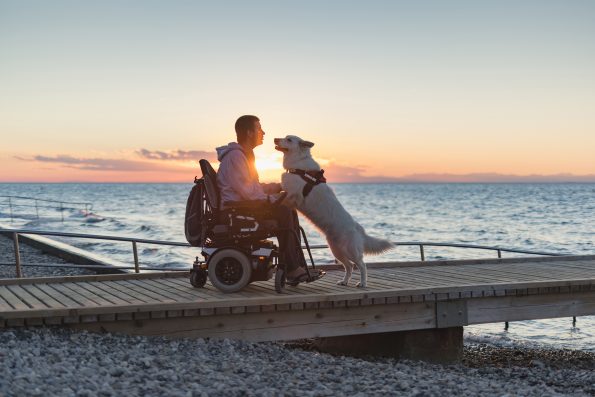The Concept Of A Service Dog Didn’t Arise Until The 1970s, But There Are Many Examples Of Dogs Helping People Throughout History

There has been evidence showcasing canines’ relationship with humans since prehistoric times. Approximately 15,000 years ago, early humans began taming wolves, turning the predatory wild animals into loyal companions of several different breeds that helped them with a variety of tasks.
Nowadays, canines continue to be of great assistance to humans, especially in the form of service dogs.
Service dogs are trained to aid people with disabilities. The concept of a service dog as we know it today did not arise until the 1970s, but before then, many examples of such partnerships can be found throughout history.
For instance, European wood carvings from the first century A.D. discovered in the ancient Roman city of Herculaneum portrayed an image of a blind man being led by his dog. In addition, Chinese scroll paintings from the Middle Ages depicted similar scenes.
The first official instruction of guide dogs occurred in the 1750s in a Paris hospital for blind people. But it wasn’t until after World War One that the more modern-day need for guide dogs began in Germany.
Thousands of soldiers came home from the war blinded by mustard gas. One day, a German doctor named Gerhard Stalling left his German shepherd with a visually impaired patient. When he returned, he noticed that the dog seemed to be particularly protective over the patient.
So, in 1916, Stalling started a program to retrain collies that had learned how to track down wounded soldiers and perform other tasks on the front line.
The dogs would then be assigned to blind veterans. The program shut down within a decade, but in 1923, the German Shepherd Dog Association opened a dog training center in Potsdam. By 1930, the center had produced 4,000 guide dogs for both veterans and civilians.
A wealthy American dog trainer, Dorothy Harrison Eustis, was highly impressed with the training center after her visit in 1927.

24K-Production – stock.adobe.com – illustrative purposes only, not the actual person
She wrote about her observations of the guide dogs and their training success. The article was published in the Saturday Evening Post.
Eustis soon received a letter from a blind 19-year-old man from Tennessee named Morris Frank. He expressed his frustrations with his lack of independence and asked her to help train a dog for him so he could show people that he didn’t always need to rely on others.
The following year, Frank traveled to Switzerland to meet with Eustis. He returned home with his new guide dog, Buddy, who gave him the confidence to strut through busy streets with confidence.
In 1929, Eustis and Frank founded The Seeing Eye, the first guide dog school in America, which is still in existence today. The Guide Dogs for the Blind Association was founded in England five years later.
In the 1970s, dogs began to assist people with other disabilities besides visual impairment, and it was all thanks to Bonnie Bergin, an American doctor and canine researcher.
The idea of service dogs was inspired by her travels abroad. During her trips to parts of Europe, Pakistan, Iran, and Afghanistan, she observed people with disabilities using donkeys and burros to aid them.
She thought dogs could do the same and went on to work with a quadriplegic woman to train the very first service dog, Abdul.
In later years, she founded several institutions for service dogs and helped pioneer the term. Since then, service dogs have been a great success.
Today, service dogs help people with a wide range of disabilities, from mobility, visual, and hearing impairments to anxiety, autism, and post-traumatic stress disorder.
Sign up for Chip Chick’s newsletter and get stories like this delivered to your inbox.
More About:Animals





